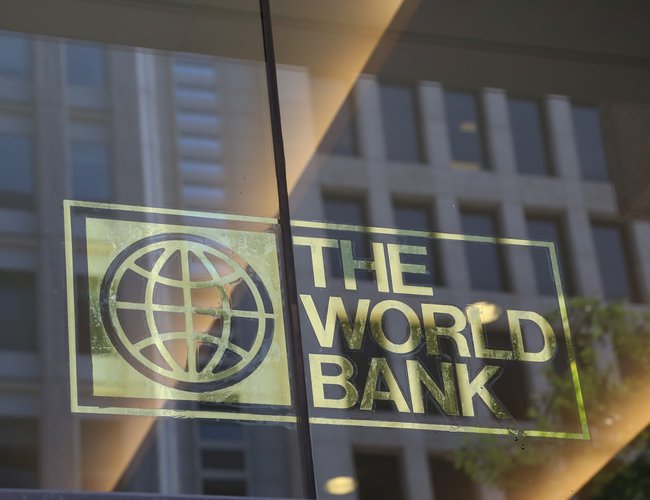
The swift and massive shock of the coronavirus pandemic and shutdown measures to contain it have plunged the global economy into a severe contraction. According to World Bank forecasts, the global economy will shrink by 5.2% this year.[1] That would represent the deepest recession since the Second World War, with the largest fraction of economies experiencing declines in per capita output since 1870, the World Bank says in its June 2020 Global Economic Prospects. For Detail: http://pubdocs.worldbank.org/en/973201588788003529/Global-Economic-Prospects-June-2020-Regional-Overview-EAP.pdf
Economic activity among advanced economies is anticipated to shrink 7% in 2020 as domestic demand and supply, trade, and finance have been severely disrupted. Emerging market and developing economies (EMDEs) are expected to shrink by 2.5% this year, their first contraction as a group in at least sixty years. Per capita incomes are expected to decline by 3.6%, which will tip millions of people into extreme poverty this year.
The blow is hitting hardest in countries where the pandemic has been the most severe and where there is heavy reliance on global trade, tourism, commodity exports, and external financing. While the magnitude of disruption will vary from region to region, all EMDEs have vulnerabilities that are magnified by external shocks. Moreover, interruptions in schooling and primary healthcare access are likely to have lasting impacts on human capital development.
“This is a deeply sobering outlook, with the crisis likely to leave long-lasting scars and pose major global challenges,” said World Bank Group Vice President for Equitable Growth, Finance and Institutions, Ceyla Pazarbasioglu. “Our first order of business is to address the global health and economic emergency. Beyond that, the global community must unite to find ways to rebuild as robust a recovery as possible to prevent more people from falling into poverty and unemployment.”
Under the baseline forecast—which assumes that the pandemic recedes sufficiently to allow the lifting of domestic mitigation measures by mid-year in advanced economies and a bit later in EMDEs, that adverse global spillovers ease during the second half of the year, and that dislocations in financial markets are not long-lasting — global growth is forecast to rebound to 4.2% in 2021, as advanced economies grow 3.9% and EMDEs bounce back by 4.6%. However, the outlook is highly uncertain and downside risks are predominant, including the possibility of a more protracted pandemic, financial upheaval, and retreat from global trade and supply linkages. A downside scenario could lead the global economy to shrink by as much as 8% this year, followed by a sluggish recovery in 2021 of just over 1%, with output in EMDEs contracting by almost 5% this year.
The U.S. economy is forecast to contract 6.1% this year, reflecting the disruptions associated with pandemic-control measures. Euro Area output is expected to shrink 9.1% in 2020 as widespread outbreaks took a heavy toll on activity. Japan’s economy is anticipated to shrink 6.1% as preventive measures have slowed economic activity.
“The COVID-19 recession is singular in many respects and is likely to be the deepest one in advanced economies since the Second World War and the first output contraction in emerging and developing economies in at least the past six decades,” said World Bank Prospects Group Director Ayhan Kose. “The current episode has already seen by far the fastest and steepest downgrades in global growth forecasts on record. If the past is any guide, there may be further growth downgrades in store, implying that policymakers may need to be ready to employ additional measures to support activity.”
Analytical sections in this edition of Global Economic Prospects address key aspects of this historic economic shock:
How deep will the COVID-19 recession be? An investigation of 183 economies over the period 1870-2021 offers a historical perspective on global recessions.
Scenarios of possible growth outcomes: Near-term growth projections are subject to an unusual degree of uncertainty; alternative scenarios are examined.
How does informality aggravate the impact of the pandemic? The health and economic consequences of the pandemic are likely to be worse in countries with widespread informality.
The outlook for low-income countries: The pandemic is taking a heavy human and economic toll on the poorest countries.
Regional macroeconomic implications: Each region is faced with its own vulnerabilities to the pandemic and the associated downturn.
Impact on global value chains: Disruptions to global value chains can amplify the shocks of the pandemic on trade, production, and financial markets.
Lasting scars of the pandemic: Deep recessions are likely to do long-term damage to investment, erode human capital through unemployment, and catalyze a retreat from global trade and supply linkages. (Published June 2)
The implications of cheap oil: Low oil prices that are the result of an unprecedented drop in demand are unlikely to buffer the effects of the pandemic but may provide some support during a recovery. (Published June 2)
The pandemic highlights the urgent need for health and economic policy action, including global cooperation, to cushion its consequences, protect vulnerable populations, and strengthen countries’ capacities to prevent and deal with similar events in the future. It is critically important for emerging market and developing economies, which are particularly vulnerable, to strengthen public health systems, address challenges posed by informality and limited safety nets, and enact reforms to generate strong and sustainable growth once the crisis passes.
Emerging market and developing economies with available fiscal space and affordable financing conditions could consider additional stimulus if the effects of the pandemic persist. This should be accompanied by measures to help credibly restore medium-term fiscal sustainability, including those that strengthen fiscal frameworks, increase domestic revenue mobilization and spending efficiency, and raise fiscal and debt transparency. The transparency of all government financial commitments, debt-like instruments and investments is a key step in creating an attractive investment climate and could make substantial progress this year.
Regional Outlooks:
East Asia and Pacific: Growth in the region is projected to fall to 0.5% in 2020, the lowest rate since 1967, reflecting disruptions caused by the pandemic. For more, see regional overview.
Europe and Central Asia: The regional economy is forecast to contract by 4.7%, with recessions in nearly all countries. For more, see regional overview.
Latin America and the Caribbean: The shocks stemming from the pandemic will cause regional economic activity to plunge by 7.2% in 2020.For more, see regional overview.
Middle East and North Africa: Economic activity in the Middle East and North Africa is forecast to contract 4.2% as a result of the pandemic and oil market developments. For more, see regional overview.
South Asia: Economic activity in the region is projected to contract by 2.7% in 2020 as pandemic mitigation measures hinder consumption and services activity and as uncertainty about the course of the pandemic chills private investment. For more, see regional overview.
Sub-Saharan Africa: Economic activity in the region is on course to contract by 2.8% in 2020, the deepest on record. For more, see regional overview.
South Asia
Although the South Asia region has witnessed a smaller number of COVID-19 cases than many other regions, tourism activity has faded, and domestic pandemic mitigation measures are weighing heavily on short-term economic activity.
Deteriorating economic conditions in advanced economies and major emerging market economies are impacting export-related industries. In addition, the incidence of COVID-19 cases is still rising rapidly regionally. Industrial and services activity has plummeted in South Asia as a result of pandemic mitigation measures and the collapse in global demand. Trade activity has sharply fallen.
Consumption has been severely hindered as nationwide lockdowns were instituted in several economies, despite some recent relaxations. Tourism has become severely constrained by the pandemic, which has led to sharp declines in arrivals in economies such as Bhutan, Nepal, Sri Lanka, and especially Maldives, where tourism accounts for a large share of output. Regional financial markets have been rattled by global market turmoil, leading to equity index declines, capital outflows, and heightened investor risk aversion, despite some recent stabilization.
One outcome is that the effects of lower oil prices and more subdued economic activity is keeping inflation generally contained in the region. Central banks in virtually all major economies in the region have been able to take measures to stimulate economic activity.
Outlook: GDP in the region is projected to contract by 2.7% in 2020 as pandemic mitigation measures hinder consumption and services and uncertainty about the course of the pandemic chill private investment.
Despite the relatively modest trade linkages the region has with advanced and major emerging economies, the sheer depth of the global contraction will weigh on economic activity.
The regional growth outlook is surrounded by high uncertainty. In India, growth is estimated to have slowed to 4.2% in FY 2019/20, which ended in March 2020. Output is projected to contract by 3.2% in FY 2020/21, when the impact of the pandemic will largely hit. Stringent measures to control the spread of the virus will heavily curtail activity, despite some support from fiscal and monetary stimulus.
Spillovers from weaker global growth and balance sheet stress in the financial sector will also weigh on activity. Pakistan (-2.6% in FY 2019/20) and Afghanistan (-5.5% in 2020) are both projected to experience contractions, as mitigation measures are anticipated to weigh heavily on private consumption.
Key labor-intensive export sectors are expected to contract sharply and recover only slowly. Growth in Bangladesh (1.6% in FY 2019/20) and Nepal (1.8% in FY 2019/20) is expected to decelerate markedly in 2020 due to pandemic-related disruptions including mitigation measures and sharp falls in exports and remittance inflows. Nepal and Maldives will be hard hit by a drop in tourism. Risks: Risks to the outlook are heavily skewed to the downside.
Despite later and initially smaller COVID-19 outbreaks relative to some other regions, cases have expanded rapidly in India, Pakistan, Afghanistan and Bangladesh. Besides the human toll, there is a risk that the pandemic will trigger a long-lasting rise in poverty, especially among the low-income countries of the region. The region has a high share of workers employed in the informal sector, which adds to the health and economic challenges of dealing with the pandemic. Should supply disruptions give rise to sharp and pervasive rises in food prices, more people could face food insecurity.
A continuation of financial market disruptions globally could add pressure to vulnerable balance sheets of the financial sectors in large economies. Spillovers from major trading partners, if more severe than expected, could weigh on economic activity; losses in supply chain linkages could lower medium-term growth prospects. Protracted low oil prices and further depressed economic activity in the Middle East and North Africa could further curtail remittance flows.
Download Global Economic Prospects Download this data World Bank Group COVID-19 Response “The World Bank Group, one of the largest sources of funding and knowledge for developing countries, is taking broad, fast action to help developing countries strengthen their pandemic response. We are supporting public health interventions, working to ensure the flow of critical supplies and equipment, and helping the private sector continue to operate and sustain jobs. We will be deploying up to $160 billion in financial support over 15 months to help more than 100 countries protect the poor and vulnerable, support businesses, and bolster economic recovery. This includes $50 billion of new IDA resources through grants and highly concessional loans.”
How Deep Will the COVID-19 Recession Be?
Key Points
- The COVID-19 global recession is projected to be the deepest since World War II, with the largest fraction of economies experiencing declines in per capita output since 1870.
- Output of emerging market and developing economies (EMDEs) is expected to contract in 2020 for the first time in at least sixty years.
- Global growth forecasts have been revised down more steeply and rapidly during the COVID-19 recession than in any other recession since at least 1990.
- Since further downgrades may be in store as forecasters absorb new information about the pandemic evolution,additional policy support measures may be needed in the coming months.
Deepest global recession since World War II.The global economy has experienced 14 global recessions since 1870: in1876, 1885, 1893, 1908, 1914, 1917-21, 1930-32, 1938,1945-46, 1975, 1982, 1991, 2009, and 2020 (Figure 1.A). Current projections suggest that the COVID-19 recession will involve adecline in global per capita GDP by 6.2 percent, making itthe deepest global recession since 1945-46, and more thantwice as deep as the recession associated with the globalfinancial crisis.
Highest synchronization of national recessions since 1870.Current forecastssuggest that,in 2020, the highest share of economies willexperience contractions in annual per capita GDPsince 1870. The share of economies in recession will be more than 90 percent, even higher than the proportion ofabout 85 percent of countries in recession at the height ofthe Great Depression of 1930-32 (Figure 1.B).
First output contraction in EMDEs since 1960.In EMDEs, per capita outputgrowth will decline by 3.6 percent. EMDEs will also mark their first output contraction, by 2.5percent, in at least the past sixty years.Current projections indicate that all regions will experiencesharp growth downturns, and five out of six regions are projectedto fall into outright recession.Advanced economies areexpected to experience a 7 percent drop in output.
Sharpest contraction in multiple indicators in six decades.In 2020, many indicators of global activity are expected to register the sharpest contractions in six decades (Figures 1.C and 1.D). Mostnotably, the COVID-19 shockhas led to a near sudden stop in a large swath of services. Global trade and oilconsumption will likely see record drops this year.
Fastest and steepest downgrades in growth forecasts.The COVID-19 recession has seen by far the fastest andsteepest downgrades in global growth forecasts among all theglobal recessions for which the consensus forecast data areavailable (Figure 1.E).The speed and magnitude of growth forecastdowngrades have also been unprecedented in both advanced economies and EMDEs, even compared to those during the 2009 global recession.
Heightened uncertainty surrounding growth forecasts.The COVID-19 recession has seen a record increase inuncertainty surrounding global growth forecasts, measuredby the dispersion of individual forecasts, since April(Figure 1.F).If the futuretrajectory of forecasts follows the typical pattern andworldwide uncertainty remains elevated, there may well befurther downgrades in global growth in coming months. As such, further policy measures to support activity, in addition to the large-scale initiatives already introduced, may be needed in the coming months.
- India’s External Affairs Ministry’s Senior Officials Says Indo-Nepal relations are ever expanding
- Jul 05, 2025
- Bhutan Government Unveils Three Pronged Strategies To Tackle Skilled Migration Crisis
- Jul 05, 2025
- Weather Forecast: Generally Cloudy Across The Country With Heavy Rain At One Or Two Places Bagmati And Koshi Provinces
- Jul 05, 2025
- FNCCI President Dhakal Urges British Companies to Invest in Nepal
- Jul 04, 2025
- Nepal Is Expected To See 60,000 People Infected with Dengue This Year
- Jul 04, 2025















